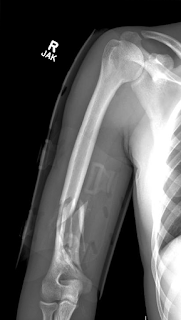Tear of the repaired subscapularis tendon after anatomic total shoulder replacement, or hemiarthroplasty remains the main concern that slows down the rehab process. In cases of rupture or stretching of the repaired subscapularis there is external rotational lag or excessive passive external rotation during clinical exam. Radiographically there can be anterior subluxation of the humeral head on axillary view of the shoulder.
I prefer to use 6 sutures for repair of the subscapularis when I re-attach it back to the humerus. The benefit of this approach is that if stretching or rupture occurs occasionally the lower 1/3 of the repaired subscapularis remains attached and thus the tendon does not retract. This is demonstrated in the picture below (C). If the rupture is complete then there is shortening and revision repair back to the lesser tuberosity may required. In such cases soft tissue releases or even augmentation with tendon allograft may be required (D)
Below there is an example of failure of the repaired subscapularis which was was found during surgery to be only stretching of the upper 2/3 of the row border of the tendon. For that reason it was easy to repair it back to the bone. Axillary xray indicates the rupture below.
This axillary view indicates that the humeral head in centered on the glenoid after the revision repair of the subscapularis tendon
This axillary view indicates anterior subluxation, failure of subscapularis
Six sutures passed through the cortical bone of the lesser tuberosity for repair of the subscapularis. Usually the upper 2/3 of the tendon fails at the repair site, or gets stretched and the lower 1/3 remains attached which helps to avoid complete retraction and shortening of the subscapularis tendon after rupture.















